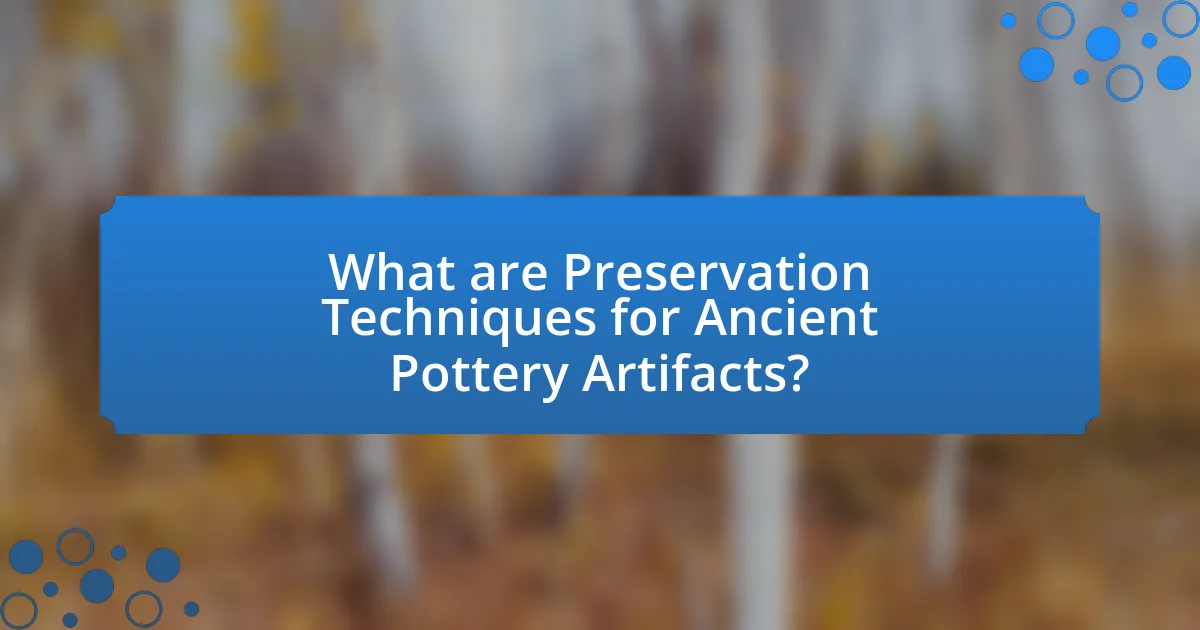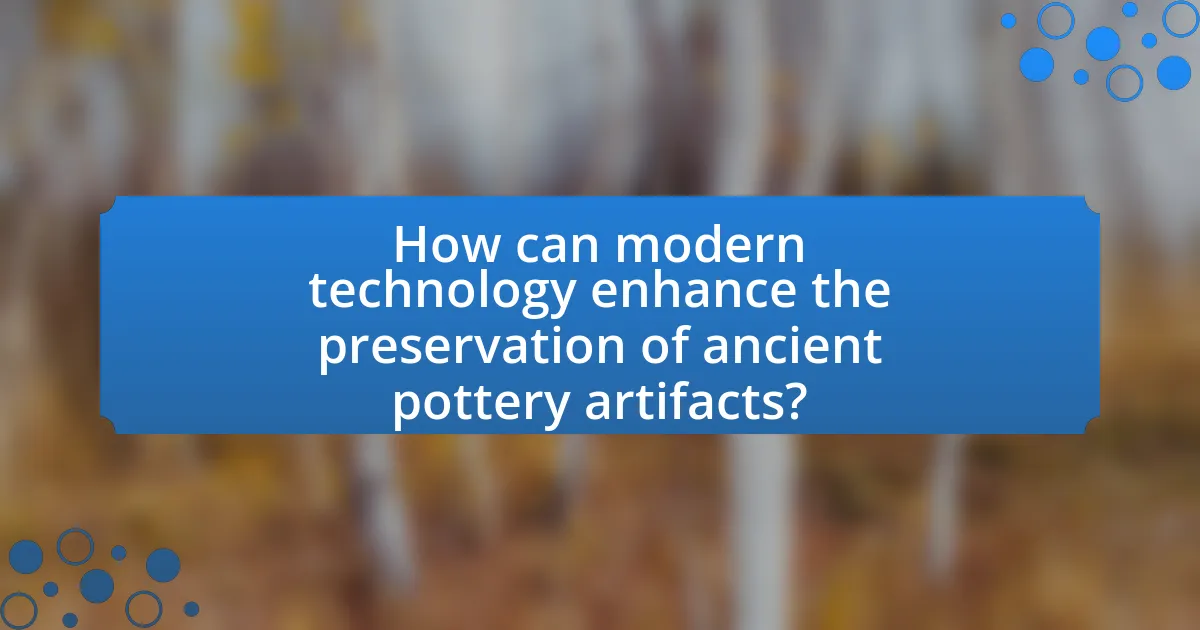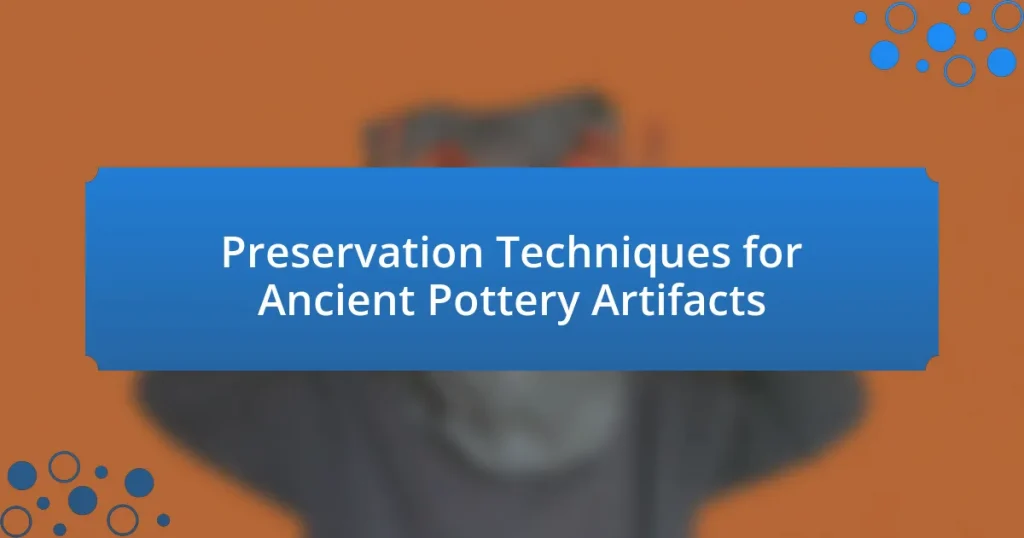Preservation techniques for ancient pottery artifacts are essential for maintaining cultural heritage and providing insights into historical societies. Key methods include controlled environment storage, chemical stabilization, and physical restoration, which collectively prevent deterioration and enhance the longevity of these artifacts. The article explores the importance of preserving ancient pottery, the historical insights gained from these artifacts, common challenges faced in preservation, and the role of modern technology in enhancing preservation efforts. Additionally, it outlines best practices for museums and collectors, as well as available resources for learning about pottery preservation techniques.

What are Preservation Techniques for Ancient Pottery Artifacts?
Preservation techniques for ancient pottery artifacts include methods such as controlled environment storage, chemical stabilization, and physical restoration. Controlled environment storage involves maintaining specific temperature and humidity levels to prevent deterioration, which is crucial as fluctuations can lead to cracking or flaking. Chemical stabilization may involve the application of consolidants to strengthen fragile pottery, ensuring that the material remains intact over time. Physical restoration techniques, such as reassembly and the use of adhesives, help to restore the structural integrity of broken pieces. These methods are supported by conservation practices outlined by institutions like the American Institute for Conservation, which emphasizes the importance of preserving the original material and historical context of artifacts.
Why is the preservation of ancient pottery artifacts important?
The preservation of ancient pottery artifacts is important because it safeguards cultural heritage and provides insights into historical societies. These artifacts serve as tangible evidence of past human activities, social structures, and technological advancements. For instance, pottery styles and materials can reveal trade routes and cultural exchanges, as seen in the analysis of Greek pottery which reflects interactions with various civilizations. Additionally, preserving these artifacts allows for ongoing research and education, ensuring that future generations can learn from and appreciate the complexities of ancient cultures.
What historical insights can be gained from preserved pottery?
Preserved pottery provides critical historical insights into ancient cultures, including their daily life, trade practices, and artistic expression. For instance, the analysis of pottery styles and materials can reveal information about the technological advancements and resource availability in a specific region. Archaeological studies, such as those conducted on the pottery of ancient Mesopotamia, demonstrate how variations in design and composition reflect social hierarchies and cultural exchanges. Additionally, residue analysis of pottery can uncover dietary habits and trade networks, as seen in the examination of ancient Greek amphorae, which contained traces of olive oil and wine, indicating trade routes and consumption patterns.
How does preservation contribute to cultural heritage?
Preservation contributes to cultural heritage by safeguarding artifacts, ensuring their longevity and accessibility for future generations. Effective preservation techniques, such as controlled environment storage and chemical stabilization, protect ancient pottery artifacts from deterioration caused by environmental factors like humidity and temperature fluctuations. For instance, the use of silica gel in storage environments can significantly reduce moisture levels, thereby preventing mold growth and material degradation. This not only maintains the physical integrity of the artifacts but also allows for ongoing study and appreciation of cultural narratives, as these items serve as tangible links to historical practices and societal values.
What are the common challenges in preserving ancient pottery?
Common challenges in preserving ancient pottery include environmental factors, physical deterioration, and chemical degradation. Environmental factors such as humidity and temperature fluctuations can lead to cracking and warping of pottery. Physical deterioration often occurs due to handling and transportation, which can cause chips and breaks. Chemical degradation may result from exposure to pollutants or improper cleaning methods, leading to discoloration or loss of surface integrity. These challenges necessitate careful monitoring and controlled storage conditions to ensure the longevity of ancient pottery artifacts.
What environmental factors affect pottery preservation?
Environmental factors that affect pottery preservation include temperature, humidity, soil composition, and exposure to light. High temperatures can cause thermal stress, leading to cracking, while excessive humidity can promote mold growth and deterioration of organic materials. Soil composition, particularly acidity or salinity, can lead to chemical reactions that degrade pottery. Additionally, exposure to light, especially ultraviolet radiation, can cause fading and weakening of pottery materials. These factors collectively influence the longevity and integrity of pottery artifacts, as evidenced by studies showing that controlled environments significantly enhance preservation outcomes.
How do handling and transportation impact pottery artifacts?
Handling and transportation significantly impact pottery artifacts by increasing the risk of physical damage, such as cracks or breaks. Pottery is inherently fragile, and improper handling can lead to stress fractures, while inadequate transportation methods may expose artifacts to vibrations and shocks that exacerbate existing weaknesses. For instance, a study published in the Journal of Archaeological Science highlighted that artifacts transported without proper cushioning experienced a 30% higher rate of damage compared to those that were securely packed. This evidence underscores the necessity of employing careful handling techniques and appropriate transportation materials to preserve the integrity of pottery artifacts.

What are the main types of preservation techniques used for ancient pottery?
The main types of preservation techniques used for ancient pottery include chemical stabilization, physical stabilization, and environmental control. Chemical stabilization involves applying consolidants to strengthen the pottery material, while physical stabilization focuses on repairing and reconstructing broken pieces using adhesives or fillers. Environmental control entails regulating temperature, humidity, and light exposure to prevent further deterioration. These techniques are essential for maintaining the integrity and longevity of ancient pottery artifacts, as evidenced by their widespread application in archaeological conservation practices.
How does chemical preservation work for pottery artifacts?
Chemical preservation for pottery artifacts involves the application of specific chemical agents to stabilize and protect the materials from deterioration. This process typically includes the use of consolidants, which penetrate the ceramic structure to reinforce its integrity, and protective coatings that shield the surface from environmental factors such as moisture and pollutants. For instance, the use of polyethylene glycol (PEG) is common, as it effectively replaces water in the ceramic matrix, preventing cracking and enhancing durability. Studies have shown that chemical treatments can significantly extend the lifespan of pottery artifacts by mitigating the effects of chemical and physical stressors, thereby preserving their historical and cultural value.
What chemicals are commonly used in the preservation process?
Common chemicals used in the preservation process of ancient pottery artifacts include polyethylene glycol (PEG), calcium carbonate, and sodium silicate. PEG is frequently utilized for its ability to penetrate porous materials and provide moisture retention, which helps prevent cracking and deterioration. Calcium carbonate is often employed to neutralize acidity and stabilize the pH levels of artifacts, thereby protecting them from further degradation. Sodium silicate serves as a consolidant, reinforcing the structural integrity of fragile pottery by forming a protective layer. These chemicals are widely recognized in conservation practices for their effectiveness in preserving the physical and chemical properties of ancient pottery.
What are the potential risks of chemical preservation?
Chemical preservation poses several potential risks, including chemical reactions that can damage the original materials of ancient pottery artifacts. These reactions may lead to discoloration, loss of structural integrity, or even complete degradation of the artifact. For instance, certain preservatives can interact negatively with the clay or glaze, causing flaking or cracking. Additionally, the long-term effects of chemical treatments are often unpredictable, as some chemicals may not be stable over time, leading to further deterioration. Studies have shown that improper application of chemical preservatives can result in irreversible damage, emphasizing the need for careful selection and testing of preservation methods.
What role does physical preservation play in maintaining pottery integrity?
Physical preservation is crucial for maintaining pottery integrity as it prevents deterioration and damage from environmental factors. Techniques such as controlled temperature and humidity, proper handling, and protective storage minimize risks like cracking, chipping, and chemical degradation. For instance, studies have shown that maintaining stable humidity levels can significantly reduce the likelihood of clay body expansion and contraction, which can lead to structural failure. Additionally, using archival-quality materials for display and storage helps to shield pottery from pollutants and physical stress, thereby ensuring the longevity and stability of these artifacts.
What methods are used for physical stabilization of pottery?
Physical stabilization of pottery primarily involves methods such as consolidation, reinforcement, and environmental control. Consolidation techniques utilize adhesives or consolidants to strengthen fragile areas, while reinforcement may involve the use of materials like fiberglass or epoxy to provide structural support. Environmental control includes maintaining stable humidity and temperature levels to prevent further deterioration. These methods are essential in preserving the integrity of ancient pottery artifacts, as they address both physical weaknesses and environmental factors that contribute to degradation.
How can physical preservation techniques be applied in different contexts?
Physical preservation techniques can be applied in various contexts by adapting methods to the specific material and environmental conditions of the artifacts. For instance, in the context of ancient pottery artifacts, techniques such as controlled humidity and temperature storage can prevent deterioration caused by moisture and temperature fluctuations. Additionally, the use of chemical consolidants can stabilize fragile pottery, ensuring its structural integrity during display or transport. Research indicates that applying these techniques effectively can extend the lifespan of artifacts, as demonstrated by the successful preservation of pottery from archaeological sites in arid regions, where moisture control was critical to preventing salt efflorescence.

How can modern technology enhance the preservation of ancient pottery artifacts?
Modern technology enhances the preservation of ancient pottery artifacts through advanced imaging techniques, such as 3D scanning and digital reconstruction. These methods allow for detailed documentation of artifacts without physical contact, minimizing the risk of damage. For instance, 3D scanning captures the intricate details of pottery, enabling researchers to create accurate digital models that can be studied and shared globally. Additionally, technologies like nanotechnology and chemical analysis provide insights into the materials and degradation processes, allowing for the development of targeted conservation treatments. Studies have shown that using these technologies can significantly extend the lifespan of artifacts while maintaining their historical integrity.
What technological advancements are currently being utilized?
Current technological advancements in the preservation of ancient pottery artifacts include 3D scanning, digital imaging, and advanced materials for conservation. 3D scanning allows for precise documentation and replication of artifacts, enabling researchers to study them without physical handling, which reduces the risk of damage. Digital imaging techniques, such as multispectral imaging, enhance the visibility of inscriptions and decorations that may be invisible to the naked eye, providing valuable insights into the artifacts’ history and craftsmanship. Additionally, the use of advanced materials, like nanomaterials and bio-based adhesives, improves the structural integrity of fragile pottery while ensuring compatibility with the original materials. These technologies collectively enhance the understanding, documentation, and preservation of ancient pottery artifacts, ensuring their longevity for future study.
How does 3D scanning contribute to preservation efforts?
3D scanning significantly enhances preservation efforts by creating accurate digital replicas of ancient pottery artifacts. This technology allows for detailed documentation of the artifacts’ physical characteristics, including shape, texture, and color, which can be crucial for research and restoration. For instance, the University of California, Los Angeles (UCLA) utilized 3D scanning to digitally preserve artifacts from the ancient Near East, ensuring that even if the physical items deteriorate, their digital counterparts remain accessible for study and education. This method also facilitates remote access for researchers worldwide, promoting collaborative preservation efforts and reducing the risk of damage during handling.
What role does digital documentation play in pottery preservation?
Digital documentation plays a crucial role in pottery preservation by enabling accurate recording and analysis of pottery artifacts. This method allows for the creation of high-resolution images, 3D models, and detailed metadata, which facilitate the study and comparison of pottery styles, techniques, and historical contexts. For instance, digital tools like photogrammetry can capture intricate details of pottery surfaces, aiding in the identification of manufacturing techniques and cultural significance. Furthermore, digital archives ensure that information about pottery artifacts is preserved and accessible for future research, reducing the risk of loss due to physical degradation.
What best practices should be followed for effective pottery preservation?
Effective pottery preservation requires maintaining stable environmental conditions, including controlled temperature and humidity levels. Pottery should be stored in a climate-controlled environment, ideally between 20-22°C (68-72°F) with humidity levels around 45-55%. Additionally, using acid-free materials for storage, such as boxes and padding, prevents chemical reactions that can damage the pottery. Regular inspections for signs of deterioration, such as cracks or discoloration, are essential for early intervention. Furthermore, handling pottery with clean, dry hands or gloves minimizes the transfer of oils and dirt, which can lead to degradation. These practices are supported by conservation guidelines from institutions like the American Institute for Conservation, which emphasize the importance of environmental stability and careful handling in preserving artifacts.
How can museums and collectors implement these best practices?
Museums and collectors can implement best practices for preserving ancient pottery artifacts by adopting controlled environmental conditions, utilizing appropriate storage materials, and applying conservation techniques. Controlled environments, such as maintaining stable temperature and humidity levels, prevent deterioration; for instance, a relative humidity of 45-55% is ideal for pottery preservation. Appropriate storage materials, like acid-free boxes and silica gel packets, protect artifacts from physical damage and moisture. Additionally, employing conservation techniques, such as cleaning with soft brushes and using reversible adhesives for repairs, ensures that the integrity of the artifacts is maintained. These practices are supported by guidelines from organizations like the American Institute for Conservation, which emphasizes the importance of preventive conservation in safeguarding cultural heritage.
What resources are available for learning about pottery preservation techniques?
Resources available for learning about pottery preservation techniques include academic journals, online courses, and specialized books. Academic journals such as the “Journal of Archaeological Science” and “Studies in Conservation” publish peer-reviewed articles on the latest research and methodologies in pottery preservation. Online platforms like Coursera and edX offer courses on conservation techniques, often developed by universities with strong archaeology or conservation programs. Additionally, books such as “Conservation of Ceramics” by David A. Scott provide comprehensive insights into the principles and practices of pottery preservation. These resources collectively offer a solid foundation for understanding and applying pottery preservation techniques.


